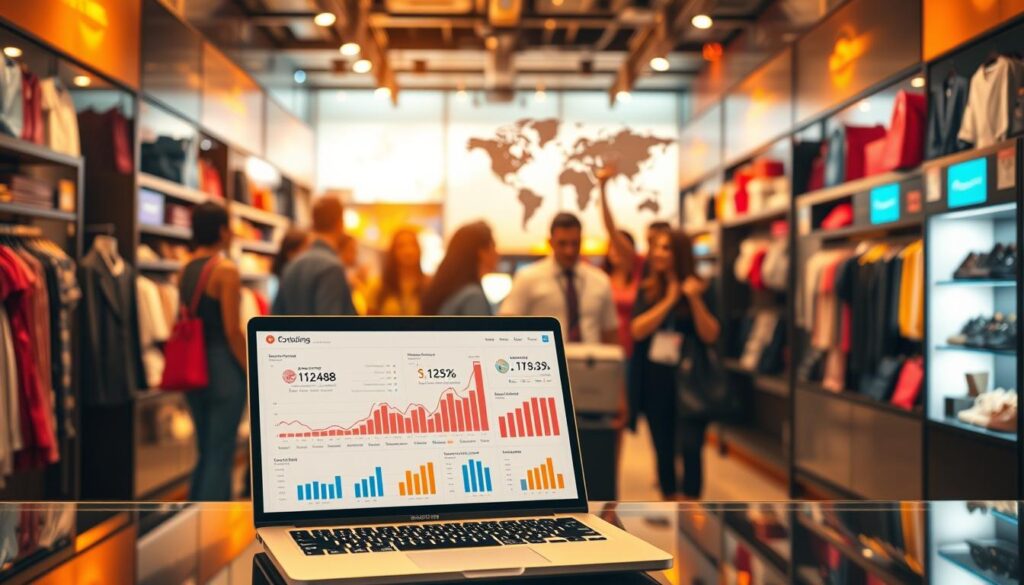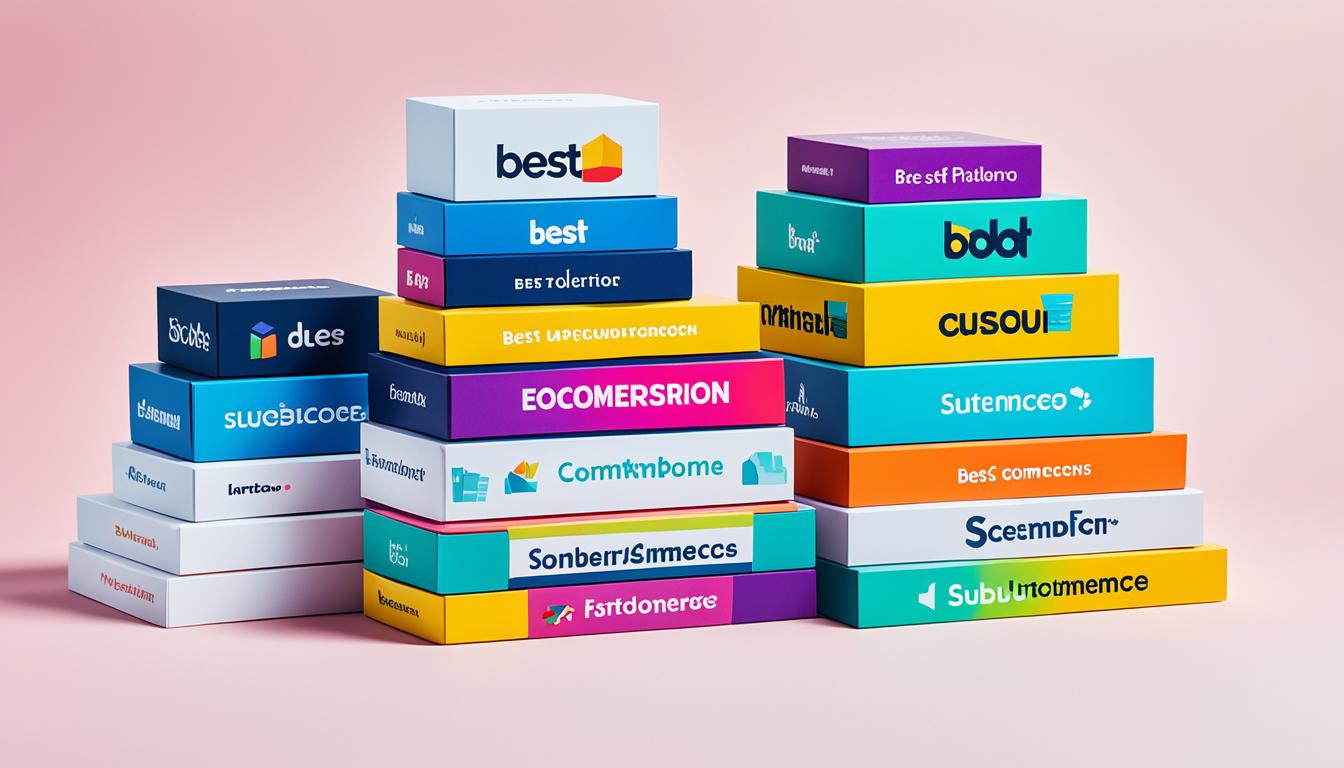In today’s digital landscape, understanding the power of social media and its impact on consumer behavior is essential. The influencer marketing industry has grown exponentially, with brands earning an average of $4.12 for every $1 spent on Instagram campaigns1. This highlights the importance of leveraging data to refine your approach and stay ahead of competitors.
With the industry projected to reach $48 billion by 2027, now is the time to dive deeper into these trends1. Whether you’re a seasoned marketer or just starting, knowing how to interpret these numbers can transform your strategy. Platforms like Instagram and TikTok are leading the charge, offering unparalleled engagement and ROI.
To stay competitive, it’s crucial to tap into reliable resources. Explore our digital library for e-books, courses, and free webinars. These tools can help you harness the full potential of influencer campaigns and make data-driven decisions.
Key Takeaways
- Influencer marketing offers an average ROI of $4.12 for every $1 spent on Instagram campaigns.
- The industry is projected to reach $48 billion by 2027.
- Social media platforms like Instagram and TikTok are key drivers of engagement.
- Data-driven strategies are essential for staying competitive.
- Accessing reliable resources can enhance your marketing skills and outcomes.
Introduction: The Impact of Influencer Marketing
The digital age has reshaped how brands connect with their audiences. My journey into understanding this transformation began with a realization: authenticity drives engagement. Platforms like TikTok and Instagram have become powerful tools for promoting products, and I’ve seen firsthand how they build trust with consumers2.
Over the years, I’ve observed how brand messaging has evolved. Content created by influencers often feels more relatable than traditional ads. This shift has made a significant impact on how products are perceived and purchased3.
My Journey into Influencer Insights
When I first started exploring the world of social media, I was amazed by the power of authentic recommendations. Influencers who genuinely love a product can sway consumer decisions more effectively than any ad campaign2.
Platforms like TikTok have become a game-changer. Their algorithm prioritizes user interaction, making it easier for brands to reach their target audience3. This has led to higher engagement rates and better ROI for campaigns.
Here’s a quick breakdown of how different platforms perform in terms of engagement:
| Platform | Engagement Rate |
|---|---|
| TikTok | 2.05% |
| 0.95% | |
| YouTube | 0.85% |
Brands are now assessing the impact of their campaigns more rigorously. By analyzing data, they can refine their strategies and achieve better results3. Learning these insights has empowered me to approach campaigns with a data-driven mindset.
If you’re looking to boost your skills, our digital library offers valuable resources. From e-books to webinars, these tools can help you harness the full potential of influencer strategies and drive meaningful engagement.
Overview of Influencer Marketing Trends
Brands are increasingly turning to social platforms to drive engagement and ROI. With the global market size estimated at $21.1 billion in 2023, the industry continues to grow at an unprecedented pace4. Understanding these trends is essential for any marketer looking to stay ahead.
ROI and Engagement Highlights
Platforms like Instagram and YouTube are leading the charge in delivering high engagement rates. For instance, Instagram posts from lifestyle influencers hold the largest share at 14.32%, while beauty topics account for 7.63%4. This shows the diversity of content that resonates with audiences.
YouTube, with its brand value estimated at $29.71 billion in 2023, remains a powerful platform for long-form content4. Marketers leveraging these platforms often see higher returns, with brands earning $5.20 for every $1 spent5.
Rise of Nano and Micro Influencers
Nano and micro influencers are gaining popularity due to their authenticity and higher engagement rates. Nano-influencers, with fewer than 5,000 followers, boast an engagement rate of 2.53%, compared to 0.92% for mega-influencers5. This makes them a cost-effective choice for brands.
On TikTok, nano-influencers have the highest engagement rate at 15.2%, followed by micro-influencers at 12.4%4. Their relatability and niche audiences make them ideal for targeted campaigns.
| Platform | Engagement Rate |
|---|---|
| TikTok Nano-Influencers | 15.2% |
| Instagram Nano-Influencers | 2.53% |
| YouTube Micro-Influencers | 1.9% |
By leveraging these trends, marketers can optimize their strategies across multiple platforms. Balancing traditional and emerging channels ensures maximum reach and ROI.
Digital Library & Free Webinars to Elevate Your Skills
Continuous learning is the key to staying relevant in today’s fast-paced online environment. Our digital library offers a wealth of resources, including e-books and courses, designed to help you master the latest trends and strategies. Whether you’re a seasoned professional or just starting, these tools can transform your approach to content creation and audience engagement.
Free webinars are another excellent way to upskill. These sessions provide actionable insights and practical tips from industry experts. For example, the Maine State Library offers over 50 free webinars covering topics like technology and community engagement. Such resources are invaluable for staying ahead in the digital space.
Explore E-books, Courses, and Web Design Resources
Creators today rely on multimedia content to connect with their audiences. Posts that include videos, infographics, and interactive elements tend to perform better, driving higher engagement and trust6. Our e-books and courses delve into these strategies, helping you craft compelling content that resonates with your audience.
Statistics show that 92% of professionals believe educational resources significantly enhance campaign effectiveness7. By leveraging these tools, you can refine your skills and achieve measurable growth. Real-world examples, like brands that have successfully integrated these resources, highlight their transformative potential.
“The right resources can turn knowledge into actionable results.”
Take proactive steps to explore our digital assets. From webinars to e-books, these resources are designed to empower you and elevate your media presence. Start today and unlock your full potential.
Understanding influencer marketing statistics
Data-driven insights are reshaping how brands connect with their audience. By analyzing key metrics, I’ve learned that every successful campaign is built on a foundation of measurable results. For example, TikTok creators, especially nano-influencers, consistently deliver high engagement rates and lower costs per interaction8.
One of the most critical metrics to monitor is the engagement rate. It reflects how actively an audience interacts with content. On TikTok, nano-influencers achieve an impressive 15.2% engagement rate, compared to 12.4% for micro-influencers8. This makes them a cost-effective choice for brands aiming to maximize ROI.
Understanding audience behavior is equally important. Metrics like click-through rates and conversion percentages reveal how consumers respond to content. For instance, 34% of consumers have made purchases on Instagram due to endorsements8. This highlights the power of authentic recommendations in driving decisions.
Here’s a breakdown of key metrics and their impact:
| Metric | Impact |
|---|---|
| Engagement Rate | Measures audience interaction with content |
| Click-Through Rate | Indicates how often users take action |
| Conversion Rate | Shows the percentage of users who make a purchase |
Analyzing both macro and micro data points is essential for a comprehensive strategy. While macro metrics provide a broad overview, micro insights, like individual post performance, offer actionable details. For example, 90% of marketers believe that leveraging these metrics significantly enhances campaign effectiveness9.
By focusing on these statistics, brands can refine their approach and achieve measurable success. Whether it’s through TikTok creators or Instagram campaigns, the right data can transform how you connect with your audience and drive meaningful results.
Platform-Specific Influencer Data
Each social media platform offers unique opportunities for engagement and growth. Understanding how users interact with content on different platforms can help businesses tailor their strategies effectively. Let’s dive into the specifics of TikTok, Instagram, Facebook, and YouTube to see how they perform and what makes them stand out.
TikTok and Social Commerce Trends
TikTok has emerged as a leader in social commerce, with 46.7% of marketers considering it the most important channel for campaigns10. Its algorithm prioritizes user interaction, making it easier for brands to reach their target audience. Nano-influencers on TikTok achieve an impressive 15.2% engagement rate, making them a cost-effective choice for businesses10.
What sets TikTok apart is its ability to drive trends and create viral content. For example, 69% of brands used TikTok in their campaigns in 2024, reflecting its growing influence10. This platform is particularly effective for industries like fashion, beauty, and lifestyle, where visual content thrives.
Instagram, Facebook, and YouTube Performance
Instagram remains a powerhouse for engagement, with 80.8% of US marketers utilizing it for campaigns11. Nano-influencers on Instagram have an engagement rate of 6.23%, significantly higher than other platforms11. This makes it ideal for businesses looking to build trust and authenticity with their audience.
Facebook, while more traditional, still holds value. Influencers on Facebook average 3.86 posts per week, ensuring consistent visibility11. YouTube, on the other hand, excels with long-form content, offering a median engagement rate of 1.9% for micro-influencers11.
Here’s a quick comparison of platform performance:
| Platform | Engagement Rate |
|---|---|
| TikTok | 15.2% (Nano-Influencers) |
| 6.23% (Nano-Influencers) | |
| YouTube | 1.9% (Micro-Influencers) |
By understanding these nuances, businesses can choose the right platform type for their industry and goals. Whether it’s TikTok’s viral potential or Instagram’s high engagement, each platform offers distinct advantages for driving growth.
Ecommerce and ROI: Measuring Campaign Success
Ecommerce brands are leveraging data to measure the success of their campaigns and maximize returns. With an average return of $6.50 for every $1 spent, understanding ROI is crucial for sustainable growth12. By analyzing key metrics, businesses can refine their strategies and ensure profitability.

Maximizing Returns Through Insights
To optimize returns, it’s essential to set clear goals and track performance. Metrics like engagement rates, click-through rates, and conversion percentages provide actionable insights. For example, 70% of brands measure ROI to assess campaign effectiveness13.
Choosing the right form of partnership is equally important. Nano-influencers, with their high engagement rates, often deliver better results at a lower cost. This allows brands to stay within their budget while achieving measurable growth.
Affiliate Sales Impact
Affiliate programs can significantly boost revenue. For instance, M&M’s saw a 457% increase in sales during a Father’s Day campaign, thanks to strategic partnerships13. These programs not only drive sales but also build long-term relationships with creators.
Tracking affiliate performance helps brands understand the direct impact of their campaigns. By calculating the influencer marketing statistic, businesses can assess effectiveness and make data-driven decisions. This approach ensures that every dollar spent contributes to overall success.
“The right data transforms how brands connect with their audience and drive meaningful results.”
For more insights on measuring ROI, explore this detailed guide. It provides actionable tips for optimizing campaigns and achieving sustainable growth.
The Role of UGC and Creator-Generated Content
Authentic content has become a cornerstone of modern brand strategies. User-generated content (UGC) and creator-generated content are reshaping how businesses connect with their audience. Unlike traditional ads, UGC feels more relatable and trustworthy, making it a powerful tool for driving conversions14.
Data shows that 84% of people are more likely to trust a brand that uses UGC in its campaigns14. This trust translates into higher engagement rates and better ROI. For example, UGC is perceived as 2.5 times more authentic than branded content, making it a key driver of consumer decisions14.
Why Authenticity Matters
Authenticity is the backbone of successful campaigns. When consumers see real people using and endorsing products, they’re more likely to make a purchase. Studies reveal that 77% of purchasing decisions are influenced by brands that utilize UGC14.
This is especially true for younger audiences. Gen Z and millennials prioritize authenticity, with 90% of consumers emphasizing its importance in choosing brands15. By incorporating UGC, businesses can create a genuine connection with their audience.
Repurposing Content Across Channels
One of the strengths of UGC is its versatility. Brands can repurpose creator-generated content across multiple platforms, from Instagram to TikTok. This not only saves time but also ensures consistency in messaging.
For instance, 98% of destination marketing organizations plan to distribute creator-made content through Instagram ads in 202414. This approach maximizes reach and reinforces brand authenticity.
“Authentic content builds trust, and trust drives conversions.”
By focusing on UGC, brands can create long-term bonds with their audience. It’s not just about a single campaign; it’s about fostering a community that believes in your brand. Start incorporating UGC today and watch your engagement rate soar.
Using AI to Enhance Influencer Strategies
Artificial intelligence is revolutionizing how brands connect with their audiences. By automating tasks and optimizing content, AI is becoming a game-changer in the digital space. Recent studies show that 75% of marketers believe strategies can be automated with AI, improving efficiency in campaign management16.
AI tools can save brands 80% of their content creation time and 65% of their budget, while enhancing campaign performance by 28%16. This makes it a valuable asset for businesses looking to streamline their efforts and maximize ROI.
Automation Benefits
One of the key advantages of AI is its ability to target followers more effectively. By analyzing extensive datasets, AI algorithms can identify the best audience demographics and engagement patterns16. This ensures that content reaches the right people at the right time.
AI also simplifies video production. Tools like Natural Language Processing and Machine Learning can generate drafts for social media updates, ensuring consistency across channels16. This not only saves time but also improves the quality of content.
Case studies show that working influencers who use AI achieve better campaign performance. For example, AI-driven predictive analytics can forecast trends, allowing for proactive adjustments in strategies16.
Ethical Considerations
While AI offers numerous benefits, it’s important to address ethical concerns. Transparency is crucial when integrating AI into campaigns. Brands must ensure that audiences are aware of how their data is being used16.
Privacy is another key issue. AI requires large volumes of personal data, so adherence to regulations like GDPR is essential16. By prioritizing ethics, brands can build trust and maintain authenticity.
“AI is a powerful tool, but its use must be guided by ethical principles.”
By leveraging AI responsibly, brands can enhance their strategies while staying true to their values. This balance is key to long-term success in the digital age.
Tips for Building Long-Term Influencer Partnerships
Building lasting relationships with creators can transform your brand’s presence online. Studies show that long-term deals, particularly on channels like Instagram, yield higher consumer trust and better collaboration outcomes17. By focusing on sustainable partnerships, you can achieve consistent growth and authenticity.
Negotiating and Nurturing Collaborations
When negotiating partnerships, I prioritize clear communication and mutual understanding of campaign goals. Long-term collaborations can enhance credibility, with 70% of consumers feeling more connected to brands they trust17. This approach ensures both parties are aligned and invested in the relationship.
Selecting the right channel is crucial. For instance, Instagram influencers often deliver higher engagement rates, making them ideal for sustained campaigns17. By leveraging reliable stats, you can identify creators who align with your brand’s values and audience.
Nurturing these relationships goes beyond single campaigns. Brands that invest in long-term partnerships see a 40% improvement in campaign performance metrics17. Regular feedback and exclusive opportunities can strengthen these bonds, fostering loyalty and creativity.
Here are some actionable tips to build lasting partnerships:
- Set clear expectations and measurable objectives from the start.
- Provide competitive compensation that reflects the creator’s effort.
- Maintain consistent communication to address concerns and celebrate successes.
- Repurpose content across multiple channels to maximize reach and impact.
“Long-term partnerships are not just about campaigns; they’re about building trust and authenticity.”
By focusing on these strategies, you can create meaningful connections that drive long-term success. Whether it’s through Instagram influencers or other channels, the right approach can transform your brand’s presence and impact.
Cost Considerations: What to Expect from Influencers
Understanding the cost structure of influencer collaborations is essential for effective budget planning. Pricing varies widely based on factors like follower count, platform, and engagement rates. Knowing what to expect can help you allocate resources wisely and maximize ROI18.
Pricing Tiers Across Platforms
Different platforms have unique pricing models. For example, Instagram and TikTok influencers typically charge around $10 per post per 1,000 followers, while YouTube averages $20 per 1,000 subscribers18. These rates can increase significantly for creators with larger audiences or higher engagement.
Here’s a breakdown of average costs across popular platforms:
| Platform | Average Cost per Post |
|---|---|
| $10 per 1,000 followers | |
| TikTok | $10 per 1,000 followers |
| YouTube | $20 per 1,000 subscribers |
| $20 per 1,000 followers |
Nano-influencers, with 1,000-10,000 followers, often charge as little as $10 per post, making them a cost-effective choice for smaller marketing campaigns18. On the other hand, mega-influencers with over 1 million followers can command thousands of dollars per post.
When planning your budget, consider the type of influencer content you need. Video content generally costs more due to higher production demands, while static posts are more affordable19. Additionally, exclusivity clauses and product samples can add to the overall expense.
For more detailed insights on pricing, explore this guide. It provides actionable tips for negotiating deals and understanding cost structures before collaborating.
By analyzing these factors, you can create a realistic budget that aligns with your goals. Whether you’re launching a short-term campaign or building long-term partnerships, transparency in pricing ensures smoother collaborations and better outcomes.
Campaign Execution and Tools for Success
Successful campaign execution relies on the right tools and strategies to maximize efficiency and results. With the right platforms, you can streamline every phase of your campaign, from planning to reporting. These tools not only save time but also enhance performance by providing actionable insights.
Leveraging Analytics and Management Platforms
Analytics tools are essential for measuring engagement and optimizing content. Platforms like Dash and Shopify Collabs centralize media management, making it easier to track performance20. These tools help you identify trends, measure ROI, and refine your strategies in real-time.
For example, HypeAuditor’s database contains 81 million profiles, offering over 35 metrics for vetting and fraud detection20. This ensures you’re working with authentic creators who align with your brand’s goals.
When managing Facebook ads, tools like Sprout Social provide access to billions of social data points. This allows you to monitor reach, impressions, and conversions across multiple channels20. Integrating influencer-generated content becomes seamless, ensuring consistency in your messaging.
Here’s a comparison of popular tools and their features:
| Tool | Key Features |
|---|---|
| Dash | Centralized media management, real-time analytics |
| Shopify Collabs | Influencer search, relationship management |
| HypeAuditor | Fraud detection, profile vetting |
| Sprout Social | Social data analysis, campaign tracking |
For budget-friendly options, platforms like Creator.co offer access to over 200 million profiles, making it easier to find the right fit20. Premium tools like Traackr provide advanced analytics for optimizing long-term relationships and campaign performance20.
Integrating these tools into your workflow can significantly boost ROI. Start by identifying your campaign goals and selecting tools that align with your needs. With the right resources, you can transform your strategy and achieve measurable success.
“The right tools not only streamline execution but also empower you to make data-driven decisions.”
By leveraging these platforms, you can enhance your campaign’s efficiency and effectiveness. Whether you’re managing Facebook ads or tracking engagement, these tools are essential for success.
Measuring Engagement and Conversion Metrics
Tracking performance metrics ensures campaigns deliver maximum value. By analyzing key indicators like engagement and conversion rates, you can refine strategies and achieve better results. Data from HypeAuditor and Aspire confirms that precise measurement leads to smarter decisions21.
Tracking Audience Interaction
Understanding how audiences interact with content is essential. Metrics like reach, impressions, and engagement rates provide actionable insights. For example, 89% of professionals believe these metrics are as effective as other channels21.
Tools like UTM tracking and promotional codes help attribute sales to specific campaigns. This allows you to measure roi accurately and allocate resources effectively22.
Optimizing Content Strategies
Data-driven insights empower you to optimize content for better performance. For instance, slight increases in engagement can significantly impact campaign success. Here are some best practices:
- Monitor key performance indicators like click-through and conversion rates.
- Repurpose high-performing content across multiple platforms.
- Use predictive analytics to forecast trends and adjust strategies proactively21.
By focusing on these techniques, you can enhance your campaign’s effectiveness and drive meaningful results.
“The right metrics transform how you connect with your audience and achieve measurable success.”
For example, campaigns that leverage Earned Media Value (EMV) calculations see a clearer picture of their roi. This formula combines impressions, likes, and comments to estimate the dollar value of engagement21.
Start implementing these strategies today to increase your campaign’s impact and achieve long-term growth.
Conclusion
The digital world evolves rapidly, and staying informed is the best way to thrive. By leveraging accurate data, you can shape strategies that deliver real results. For instance, brands earn an average of $5.78 for every dollar spent, highlighting the power of informed decisions23.
This year, take a proactive approach to learning. Explore digital libraries and free webinars to stay ahead. These resources can help you refine your skills and achieve measurable growth.
Looking ahead, the potential for success is immense. I believe that authentic connections and data-driven strategies will continue to drive meaningful results. Now is the time to act and share your experiences.
What’s your take on these trends? Join the conversation in the comments below and let’s grow together.
FAQ
How can influencer insights improve my strategy?
By analyzing engagement rates, ROI, and platform-specific trends, you can tailor your approach to resonate with your target audience and maximize results.
Why are nano and micro creators gaining popularity?
They often have higher engagement rates and more authentic connections with their followers, making them effective for niche campaigns.
What resources can help me learn more about this field?
Explore e-books, free webinars, and courses to deepen your understanding and stay updated on the latest trends.
How do TikTok and Instagram differ in performance?
TikTok excels in short-form video and social commerce, while Instagram remains strong for visual storytelling and brand collaborations.
How can I measure the success of my campaigns?
Track metrics like engagement rates, affiliate sales, and ROI to evaluate performance and refine your strategy.
Why is user-generated content so effective?
It builds trust and authenticity, which can drive higher conversion rates compared to traditional ads.
Can AI enhance my influencer strategies?
Yes, AI tools can automate tasks like content analysis and audience targeting, saving time and improving efficiency.
How do I build long-term partnerships with creators?
Focus on clear communication, fair negotiations, and nurturing relationships to foster trust and collaboration.
What should I budget for influencer collaborations?
Costs vary by platform and creator tier, so research pricing trends and align your budget with campaign goals.
What tools can help manage campaigns effectively?
Use analytics and management platforms to track performance, streamline workflows, and optimize content strategies.
How do I track audience interaction effectively?
Monitor metrics like likes, comments, shares, and click-through rates to gauge engagement and adjust your approach.








